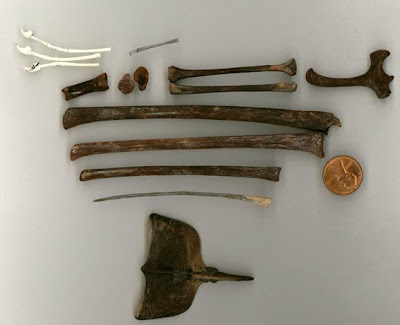 Bruce Mohn
Bruce Mohn is a palaeo-artist who has produces fine models of dinosaurs and other prehistoric species, including
Pterodactylus and
Rhamphorhynchus. Many of his works are in museums and I admire his skill and accuracy in portraying these subjects. Above is one of his pictures showing some of the bones of his
Rhamphorhynchus model during development.
I thought it would be a good idea to have a go and produce a model of my own. Bruce modelled much of his
Rhamphorhynchus bones on
R. gemmingi. I thought it would be fun to have a go at another species,
R. longimanus (Just because I have lots of photographs).

Having made a basic modelling kit from bits of driftwood and an ice-cream lolly stick, I went out and purchased some modelling clay. The best option seemed a plastic clay which can be baked hard when shaped. There are several types on the market -
Fimo is easy to work, but contracts a little when baked.
Sculpey requires a bit more skill to work, but has the advantage of retaining its size when baked. It can also be re-baked several times and sanded or carved when set. There are also several types of air dry clay, but you need to be very good to complete a model in one go. I chose Sculpey modelling clay.

The first stage in the operation is to take a small piece of clay and kneed it between your fingers until it is soft. Shape a blank (A) which is the shape you need, but simple in form. Bake at 125°C for 20 minutes (30 minutes for big bits) and cool. The blank shape can be carved and built up using more clay to form the basic shape of the bone (B). This can then be baked again to harden the added detail. Carving, sanding, building up and baking can be done as many times as necessary. The final bake needs to be at 130°C for 30 minutes. If you go any hotter, the structure of the clay will blow out and release gas.
I was quite please with the final trial model of the humerus. It just needs a little dressing and painting to make a passable display specimen. The quality of my first piece of work does not compare with the professional finish on Bruce's work, but everyone starts as a novice, it can only get better with time.
The Sculpey clay also works well in fairly flat silicon moulds. I have reproduced castings of trilobite specimens using this medium with very good results.





























